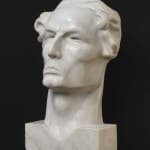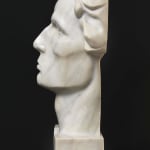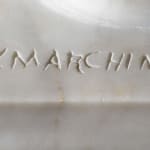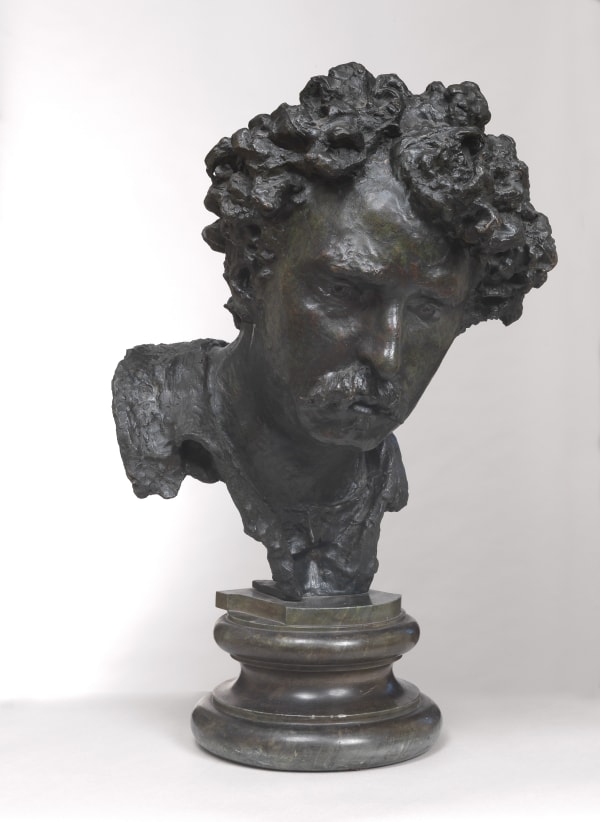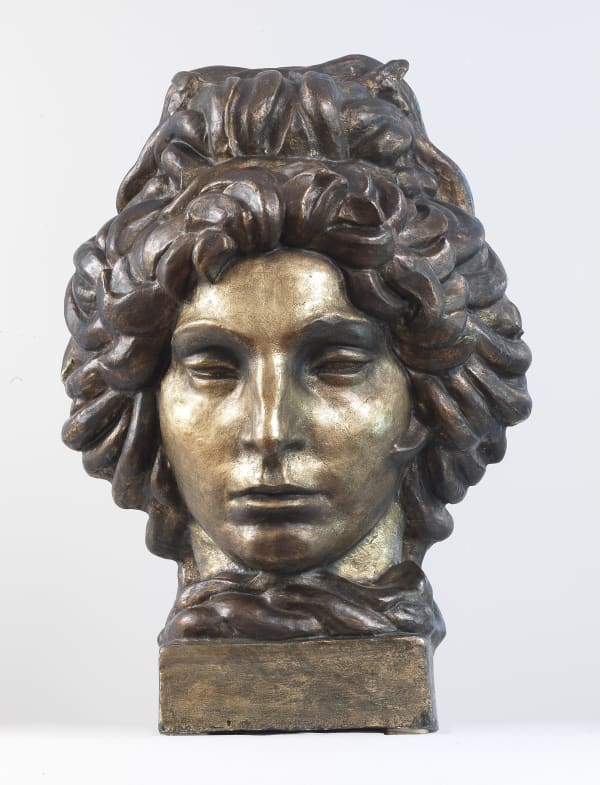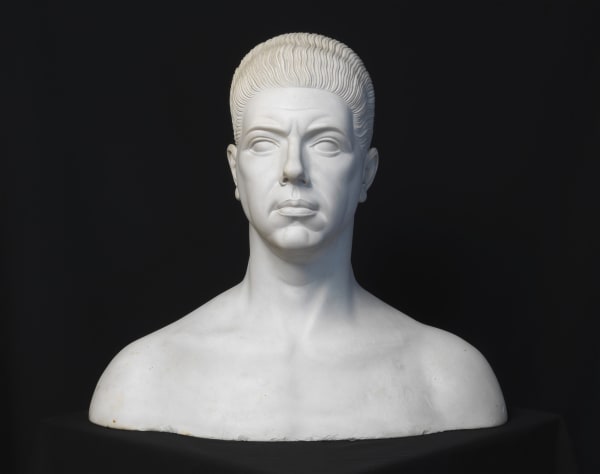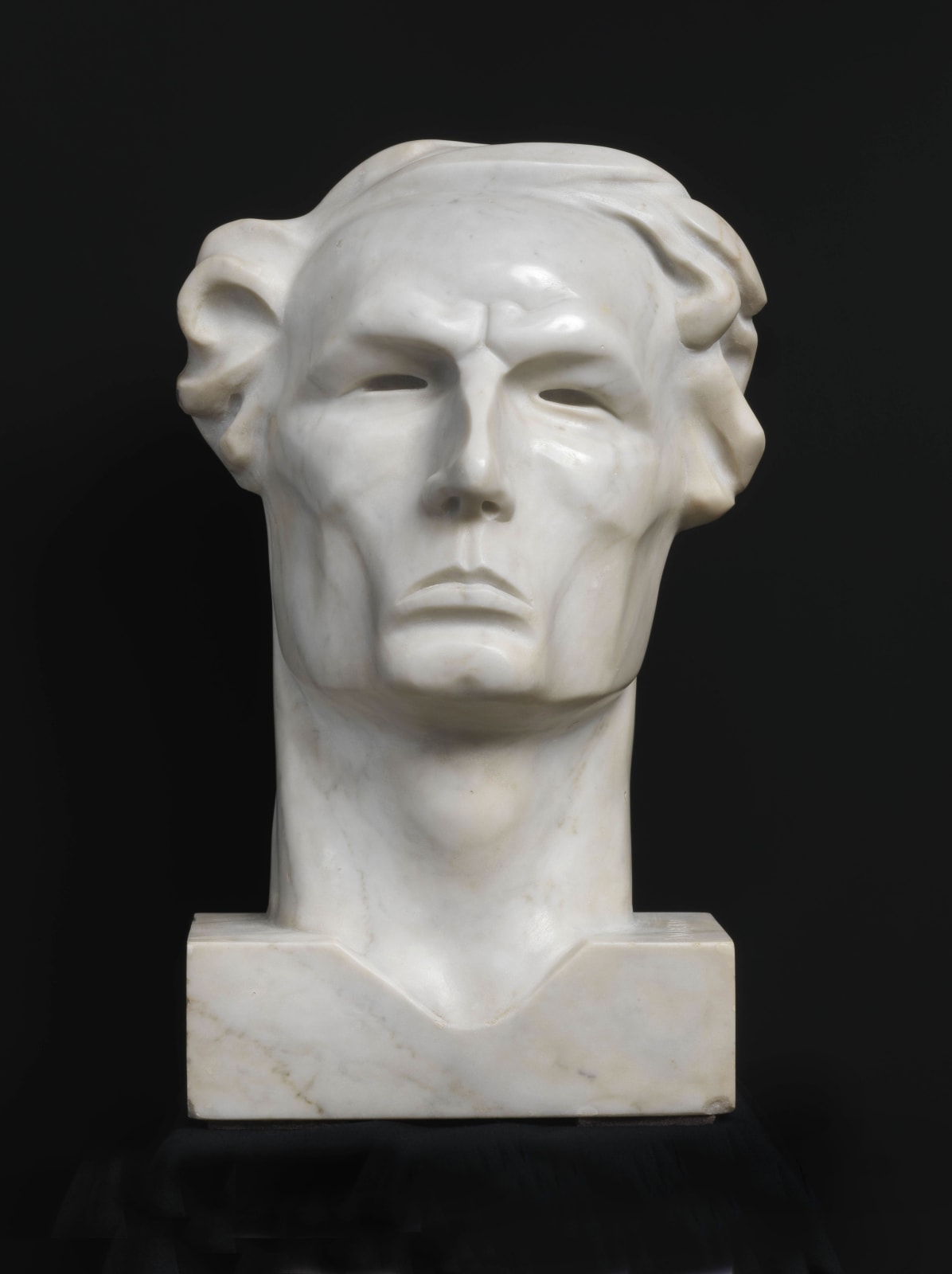



VITALIANO MARCHINI Melegnano, 1888-1971
Further images
Provenance
Milan, Regazzoni collection; Rome, private collection
Exhibitions
Palazzo Cucchiari, Novecento a Carrara. Avventure artistiche tra le due guerre, curated by Massimo Bertozzi, Carrara, 24 June – 29 October 2023
Literature
Novecento a Carrara. Avventure artistiche tra le due guerre, catalog of the exhibition at Palazzo Cucchiari, Carrara, 24 June – 29 October 2023, p. 117.
“La scoltura è prima di tutto l’arte dello scolpire, l’arte di far palpitare la vita per virtù d’ingegno e di mano, là dove essa sembra più esularne, nel sasso”.
(A. Wildt, L’arte del Marmo, 1921)
Ardito is a masterful exemplar by the sculptor Vitaliano Marchini, a white marble belonging to the Regazzoni collection dated 1919, recalled in the affectionate tribute which the local newspaper “Il Melegnanese” (1) devoted to him after his death, as one of the artist’s most remarkable works. The title might refer to the “arditi”, the heroic infantry body of the Italian Royal Army active in the First World War, during which Marchini had enlisted first in the 7th infantry regiment and later in the Alpine troops.
Arditois executed a period when Marchini was already fully aware of his expressive possibilities. The years of his studies – when he was more or less self-taught – and of his difficult beginnings were already a distant memory when, after having been a workshop assistant at the studio of Luigi Panzeri, in the first decade of the twentieth century he timidly began to take part in the exhibitions of La Permanente. Noticed by the critics ever since his début exhibition in 1906, he had obtained his first successes at the Brera National Exhibition in 1910 with Prime Fatiche, winning the Tantardini Prize, and then, in 1912,(2) again at the Brera, with the bronze group Piccola Madre, with which he obtained the Fumagalli Prize for Sculpture.
A devotee of the highly refined style of Adolfo Wildt (Milan, 1868-1931), inspired by his smooth essential forms and clear, defined lines, in this sculpture Marchini shows that he also, and above all, learned from Wildt that search for the psychological effect of the subject, so well expressed also in the Bimbo Malato exhibited at the 12th Venice Biennale in 1920, coeval to the portrait in question.
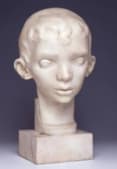
Bimbo Malato, 1920 ca., Milan
Despite the fact that, in this case, the sculptor did not arrive at drilling all the way through the material, in order to create that extremely dramatic effect which Wildt used to achieve, the man’s gaze is still obtained from the deep openings of the orbits, the dark areas clearly identified; an expression of otherness stamped on his lips and the sunken face accentuated by the chiaroscuro that contrasts with other parts, more fully lit by the light.
The marble almost seems to have been transformed into wax by the artist’s patient workmanship: this portrait is, as Wildt used to say, a sculpture “criss-crossed by rays of light”.(3)
However, far from the tormented style of his mentor,(4) Marchini has directed his search towards less broken-up, grief-stricken forms: his portrait of a man is not of suffering, is not interrogative; instead, it possesses its own certainties and is gazing into the distance; it is, when all is said and done, a more serene sculpture, which heralds those broad and continuous lines of the exemplars of his maturity.
In fact, it was around the middle of the 1920s that the sculptor began to distance himself from Wildt. Similar to what Carlo Bonomi was doing in these same years – yet another great master of the Lombardy area who is not often remembered today – his sculpture gradually achieved results of greater formal simplification, a trend noted in a positive way by the critics in 1925, when Piero Torriano in “Emporium” noted the beautiful marble group of the Deposizione “for the correct distribution of its parts, the sobriety of its modelling, the finesse of its feeling.”(5) In some ways, the figure of the Christ in the Deposizione, which shows the traces of that search “à la Wildt”, can be said to be still similar to our portrait, whereas, instead, the figure of the Madonna has already found that typical breadth of the following years, and helps to assert a later dating for our work.
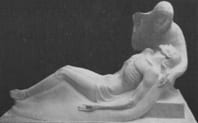
Deposizione, a work exhibited in 1925
The difficulty in finding iconographic sources coupled with exhibition catalogues that were often poorly illustrated, for the moment prevent us from tracing this beautiful work’s exhibition history, in order to fit it properly into Marchini’s long artistic career.
Notes:
1) Marchini vive ancora nelle sue opere, in “Il Melegnanese”, 1971, a. IV, n. 16, Melegnano, 1 settembre 1971, pp. 1-5, in part. p. 4
2) Il 1912 è anche l’anno in cui Wildt espone la “Trilogia ( il Santo, Il Giovane, Il Saggio)”, una delle sue opere più conturbanti.
3) Adolfo Wildt, L’arte del Marmo, seconda edizione, Hoepli, Milano 1922, p. 63
4) Va notato che l’iniziale influenza di Wildt era stata poco apprezzata dalla critica che, nei primi anni Venti, lo aveva accusato addirittura di “manierismo” (cfr: s. a., Cronache milanesi, in “Emporium”, Vol. LV, n. 326, Bergamo 1922, p. 117 ).
5) Piero Torriano, Cronache milanesi. La mostra di Brera, in “Emporium”, Vol. LXII, n. 371, Bergamo 1925, pp. 332 – 333
Biographical notes:
Vitaliano Marchini (Melegnano, nr Milan, 1888 - 1971)
Of humble origins, in the beginning Marchini was virtually self-taught. After starting work from an early age, he finally entered the studio of Luigi Panzeri as a workshop assistant, and began to take part in exhibitions, including Milan’s La Permanente in 1906 (his début), and the Brera National Exhibition where, in 1910 with Prime Fatiche, he won the Tantardini Prize, and then, in 1912, again at the Brera, the Fumagalli Prize for Sculpture with his bronze group Piccola Madre.
With a “Prova d’Artista”, in 1914 he began to exhibit at the Venice Biennale, an appointment that would often be repeated over the years, e.g. in 1920, when he exhibited Bimbo Malato, culminating in an important ‘personal room’ (one-man show) at the 18th Venice Biennale in 1932, where he presented sixteen works.
In 1921, he married Piera Zucchelli, obtaining that same year the position of teacher of figure modelling at the art school of the Brera Academy. His long-awaited consecration took place in 1922 with a one-man show at Milan’s Galleria Pesaro, together with the painters Ugo Bernasconi, Raoul Viviani, and a catalogue with an introduction by Adolfo Wildt, at which he exhibited 36 works between marbles and bronzes. After which, more exhibitions were held, including several at the Brera and the Exhibitions of the Novecento Italiano organized by Margherita Sarfatti. In 1927, he became a teacher at the Brera Academy.
His works can be found at the Gallery of Modern Art in Rome (La Siesta), at the Palace of Justice in Milan (La Condanna di Caino, 1936 – 39), at the Hospital of Niguarda as well as those of Garbagnate and Santa Corona in Pietra Ligure. His subsequent work would be characterized by a strong propensity for sacred themes; his statues for Milan Cathedral depicting St. Bernard (1938) and the Archangel Gabriel (1940) date to this period.
Literature:
Esposizione Nazionale di Belle Arti, catalogo della mostra, Milan 1910, p. 29;
Pasquale De Luca, L'Esposizione Nazionale di Brera, in “Emporium”, Vol. XXXVI, n. 214, Bergamo 1912, p. 308;
Esposizione Nazionale di Belle Arti, R. Accademia di belle Arti in Milano, exhibition catalogue, autunno 1916, Renato Romitelli, Milan 1916, p. 35, n. 72;
Esposizione annuale 1920, Mostre postume dei pittori Francesco Didioni e Achille Tominetti, exhibition catalogue, Brera, Milan, Vitali, 1920, p. 18
s. a., Cronache milanesi, in “Emporium”, Vol. LV, n. 326, Bergamo 1922, p. 117; Mostra individuale dei pittori Ugo Bernasconi, Raoul Viviani e dello scultore Vitaliano Marchini, exhibition catalogue, Galleria Pesaro, Milan 1922;
Giorgio Nicodemi, Artisti ed opere alla "Quadriennale" torinese, in “Emporium”, Vol. LVII, n. 341, Bergamo 1923, p. 309;
Società per le Belle arti ed Esposizione permanente, Esposizione annuale, November-Dicember 1924, Milan 1924, nn. 179,194;
Piero Torriano, Cronache milanesi. La mostra di Brera, in “Emporium”, Vol. LXII, n. 371, Bergamo 1925, pp. 332 - 333
Esposizione nazionale d'arte, exhibition catalogue, Milan 1925, pp. 27, 30;
Novecento italiano, exhibition catalogue, Milan 1926, pp. 27 e 71;
Raffaello Giolli, Cronache milanesi. La Biennale di Brera, in “Emporium”,Vol. LXVI, n. 394, Bergamo 1927 p. 254
XVI Esposizione internazionale d'arte, catalogo della mostra, Venezia 1928, pp. 97, 112;
Raffaello Giolli, Cronache milanesi. La mostra del sindacato. La mostra della Famiglia Artistica, in “Emporium”, Vol. LXX, n. 420, Bergamo 1929, p. 369
Vincenzo Costantini, Cronache milanesi. La mostra del sindacato lombardo. Artisti del Belgio. Altre mostre, in “Emporium”, Vol. LXXV, n. 447, Bergamo 1932, p. 183
Ugo Nebbia, La Diciottesima Biennale. Gli italiani, in “Emporium”, Vol. LXXV, n. 450, Bergamo 1932 p. 386
Guglielmo Usellini, Orientamenti dell'arte d'oggi, in “Emporium”, Vol. LXXVI, n. 451, Bergamo 1932, p. 16
Vincenzo Costantini, Milano. Le mostre collettive. Micheli, De Stefani e Fagioli. Bernasconi, De Grada e Caligiani. De Chirico, Soldati, Rosai e Cesetti. Ancora avanguardia. Il Presepio di Milano, in “Emporium”, Vol. XCI, n. 542, Bergamo 1940 p. 99
Anna Dal Pozzo Gaggiotti, Milano. La Mostra Sindacale Provinciale, in “Emporium”, vol. XCV, n. 565, 1942, p. 35
In memoria di Vitaliano Marchini, in “Il Melegnanese”, 1971, a. IV, n. 16, Melegnano, 1 settembre 1971, pp. 1-5;
Luciano Caramel, Carlo Pirovano, Galleria d'arte moderna. Padiglione d'arte contemporanea. Raccolta Grassi, Milan 1973, pp. 21 s., tavv. 103, 304-306;
G. Sannazzaro, Pitture e sculture, in L'arte nel territorio di Melegnano, Milano 1977, p. 139;
A. Casmerini, Melegnano non dimentica Marchini grande scultore, serio maestro, in “Il Cittadino”, Lodi August 25 1992, p. 22;
Mario de Micheli, La scultura del Novecento, Garzanti editore 1992, p. 40
Sculture italiane del primo Novecento (catal.), curated by V. Sgarbi, Bologna 1992, pp. 140 s.;
Milano anni Trenta. L'arte e la città, exhibition catalogue curated by Elena Pontiggia and Nicoletta Colombo, Milan 2004, pp. 170, 258;
M. Picciau, Vitaliano Marchini, text, in Galleria nazionale d'arte moderna. Le collezioni. Il XX secolo, curated by S. Pinto, Milan 2005, p. 164;
Elena Pontiggia, Storia del Novecento Italiano. Poetica e vicende del movimento di Margherita Sarfatti 1920-1932, Con un’antologia di opere della collezione VAF-Stiftung, Allemandi editore 2022.
Join the mailing list
Subscribe to our newsletter to receive all the news about exhibitions, fairs and new acquisitions!

